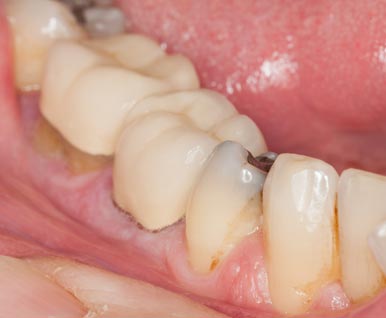-

Opening Hours
view our working time
-
Call us: +91 4936208777
+919562488777
Gum Disease
The mouth is a busy place, with millions of bacteria constantly on the move. While some bacteria are harmless, others can attack the teeth and gums. Harmful bacteria are contained in a colorless sticky film called plaque, the cause of gum disease. If not removed, plaque builds up on the teeth and ultimately irritates the gums and causes bleeding. Left unchecked, bone and connective tissue are destroyed, and teeth often become loose and may have to be removed.
In the early stage of gingivitis( Gum Disease) , the gums can become red and swollen and bleed easily, often during toothbrushing. Bleeding, although not always a symptom of gingivitis, is a signal that your mouth is unhealthy and needs attention. The gums may be irritated, but the teeth are still firmly planted in their sockets. No bone or other tissue damage has occurred at this stage

Causes of gum disease
Smoking. Need another reason to quit smoking? Smoking is one of the most significant risk factors associated with the development of gum disease. Additionally, smoking can lower the chances for successful treatment. Hormonal changes in girls/women. These changes can make gums more sensitive and make it easier for gingivitis to develop. Diabetes. People with diabetes are at higher risk for developing infections, including gum disease. Other illnesses. Diseases like cancer or AIDS and their treatments can also negatively affect the health of gums. Medications. There are hundreds of prescription and over the counter medications that can reduce the flow of saliva, which has a protective effect on the mouth. Without enough saliva, the mouth is vulnerable to infections such as gum disease. And some medicines can cause abnormal overgrowth of the gum tissue; this can make it difficult to keep teeth and gums clean. Genetic susceptibility. Some people are more prone to severe gum disease than others.How it affects your Oral Health ?
- Bad breath that won’t go away
- Red or swollen gums
- Tender or bleeding gums
- Painful chewing
- Loose teeth
- Sensitive teeth
- Receding gums or longer appearing teeth
Treatments available
The goal of periodontal treatment is to control any infection that exists and to halt progression of the disease. Treatment options involve home care that includes healthy eating and proper brushing and flossing, non-surgical therapy that controls the growth of harmful bacteria and, in more advanced cases of disease, surgery to restore supportive tissues.
During a typical checkup your dentist or dental hygienist will remove the plaque and tartar from above and below the gumline of all your teeth. If you have some signs of gingivitis, your dentist may recommend that you return for future cleanings more often than twice a year.
If your dentist determines that you have some bone loss or that the gums have receded from the teeth, the standard treatment is an intensive deep-cleaning, non-surgical method called scaling and root planing (SRP). Scaling scrapes the plaque and tartar from above and below the gumline. Root planing smoothes rough spots on the tooth root where germs collect and helps remove bacteria that can contribute to the disease. This smooth, clean surface helps allow the gums to reattach to the teeth.

